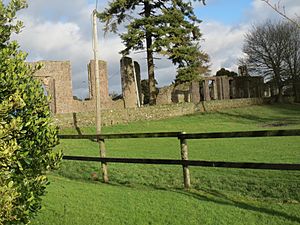Jigginstown Castle facts for kids
Quick facts for kids Jigginstown Castle |
|
|---|---|
| Native name Irish: Caisleán Bhaile an tSigínigh |
|
 |
|
| Location | Jigginstown, Naas, County Kildare, Ireland |
| Built | late 1630s |
| Lua error in Module:Location_map at line 420: attempt to index field 'wikibase' (a nil value). | |
Jigginstown Castle is an amazing old building from the 1600s. It's now a ruin, but it was once planned to be one of the biggest and most important houses in Ireland. You can find it near Naas, in County Kildare. This special place is also known as a National Monument, which means it's protected because of its history.
Contents
Building a Grand Castle
Jigginstown Castle was started in the late 1630s. This was a time when King Charles I ruled England and Ireland. The castle was meant to be very grand. It was one of the largest buildings ever planned in Ireland at that time. It was also special because it was the first big building made from red brick. Inside, the plans included fancy floors and tall columns made from Kilkenny marble.
Location and Importance
The castle was built on the edge of an area called The Pale. This was a part of Ireland near Dublin that was controlled by the English. People living there, often called English plantation settlers, guarded the area. They wanted to protect important things like valuable goods and farm animals. Jigginstown Castle was sometimes also called Siggingstown Castle.
The Man Behind the Plan
The person who wanted to build Jigginstown Castle was Thomas Wentworth. He was known as the Earl of Strafford. In the 1630s, he was the Lord Lieutenant of Ireland. This meant he was the King's main representative and the most powerful person in Ireland.
A Royal Residence
Lord Strafford had a big dream for Jigginstown Castle. He wanted it to be a special place where the King could stay when he visited Ireland. It was meant to be a royal home, fit for a king.
Why It Was Never Finished
Sadly, Jigginstown Castle was never completed. Lord Strafford faced many problems and lost his power in 1641. Because of this, the building work stopped. The castle was also badly damaged during a time of fighting and trouble in the 1640s.
Even though it was never finished, parts of the castle still stand today. You can still see the basement and the ground floor. A writer named Veronica Wedgwood, who wrote about Lord Strafford, said that the ruins were still easy to see even in the 1950s.
Images for kids


